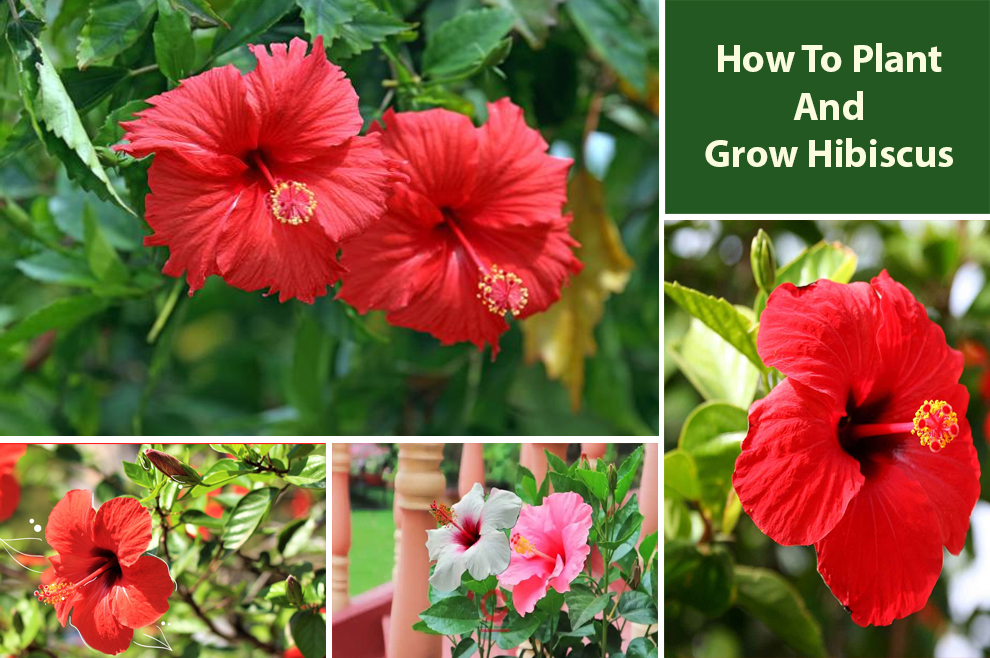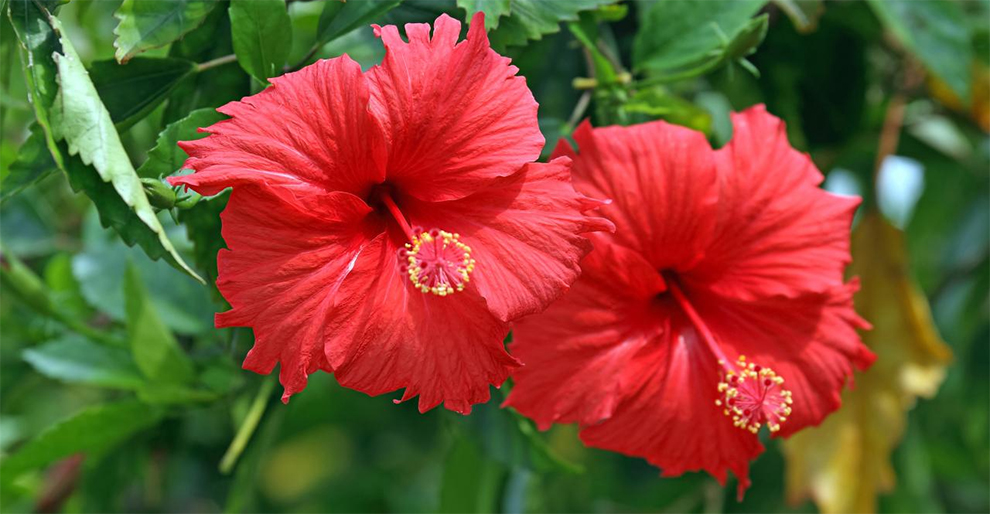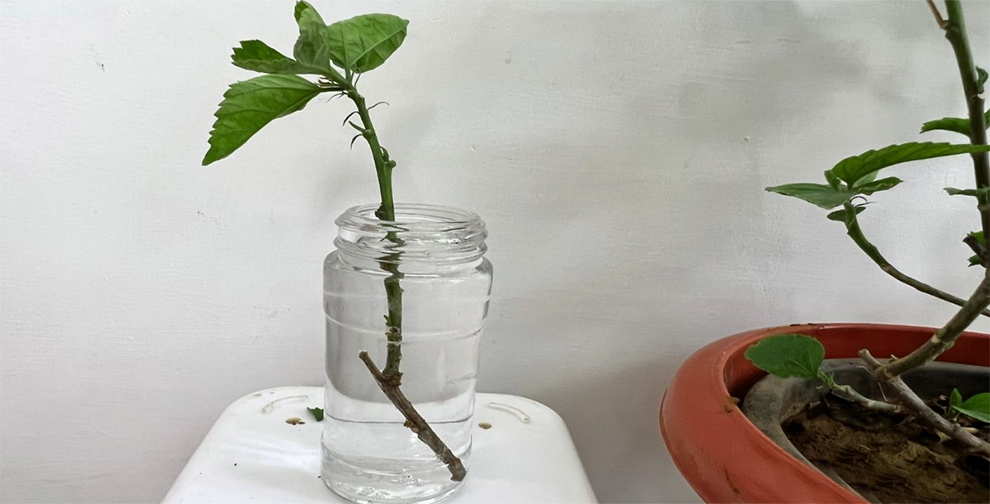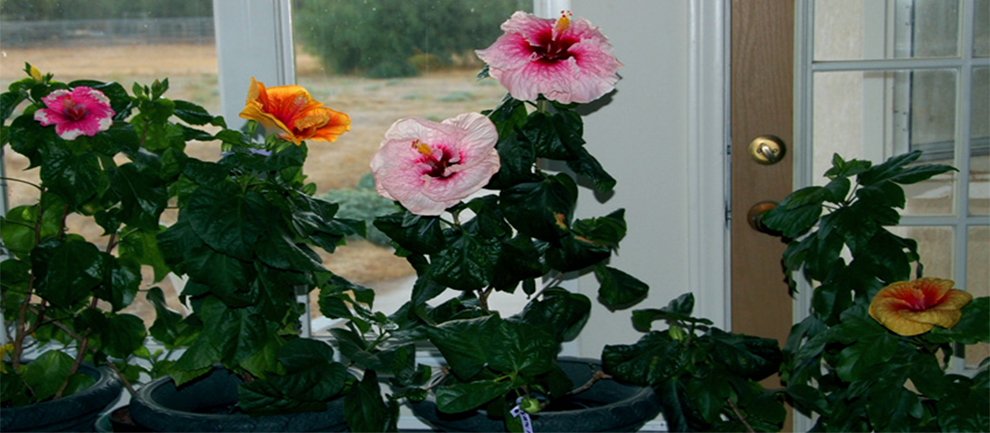How To Grow Hibiscus Plant From Seeds, Cuttings & Stem
Basically you can grow hibiscus from seeds, cuttings or a store bought plant that has already established itself. Hibiscus thrives in warm temperatures with bright light and well draining soil.

Hibiscus plants are famous for their showy, vibrant flowers and lush foliage. They can be an excellent addition to any landscape or garden. To have healthy blooms and enjoy their beauty, you must know how to grow hibiscus plants.
Here, we will take you through that in detail. You can use several methods of planting hibiscus plants, including rooted transplants, cuttings, and seeds.
One of the most prevalent ways to grow a hibiscus plant is through cutting. It involves taking a cutting from an established, healthy plant and rooting it in the soil or water until it forms roots and is ready for transplantation.
Another way to grow hibiscus plants is through seeds. You can buy seeds from the nursery or collect them from existing plants. Sow the seeds in well-draining soil and keep them moist until germination.
Lastly, you can also grow hibiscus from transplants that are young plants already started from cuttings or seeds, ready to be planted in the container or ground.
Regardless of the method of growing hibiscus plants, they will be easy to grow and produce a beautiful show of colorful foliage and flowers.
Is Hibiscus Easy To Grow?

Generally speaking, if you know how to plant hibiscus, they are easy to grow. However, their difficulty level can vary depending on the growing conditions and the variety chosen. Here are some factors you must consider before growing hibiscus plants:
1. Climate: Hibiscus is a tropical or subtropical plant. Hence, they thrive in warm temperatures. You can grow them as annuals in cooler climates, but they grow as perennials in warmer regions.
2. Soil: The hibiscus plant thrives in well-draining soil with organic matter. They will not survive in waterlogged soil.
3. Watering: The plant likes the soil to be moist, not waterlogged. So, you will have to give it regular watering. Insufficient water can cause leaf drop if the plant becomes too dry.
4. Sunlight: Hibiscus plants cherish bright, direct sun for at least six hours daily to thrive. Inadequate sun can cause poorer growth and fewer blooms.
5. Fertilization: You must fertilize them with a balanced plant feed. Over-fertilization can cause excessive vegetative growth and result in fewer blooms.
Does Hibiscus Grow Better In Pots Or Ground?
Before we learn how to plant hibiscus, we must know whether they grow better in the ground or in pots. So, fortunately, you can successfully grow them in pots and on the ground. However, the choice depends on the growing conditions and your preference.
Growing hibiscus in pots can be beneficial as it gives you more control over the plant’s environment, such as exposure to light, drainage, and soil quality. It also simplifies how you move the plant indoors during winters, especially in cooler climates where hibiscus grows as annuals.
Further, planting hibiscus in pots can also help manage the plant’s size and prevent it from becoming too large for the space.
But the hibiscus grown in the ground will have more space to spread the roots and become bigger. They will also have access to natural soil nutrients and need less watering than potted plants. Beyond this, planting the hibiscus in the ground allows for a more integrated and natural look within the garden or landscape.
How To Grow Hibiscus From Seed?
Here are the steps you must follow to grow hardy hibiscus from seeds:
- Collect the seeds from a mature plant or buy them from a reputable source online or offline.
- Soak these seeds in warm water overnight. It can soften the hard seed coat.
- Fill in the seed-starting tray or small pots with a sterile potting mix that is moist, not waterlogged.
- Sow the seeds on top of the soil and cover them with a thin layer comprising soil mix.
- Cover the pot or the tray with a plastic wrap or dome to form a humid temperature for the seeds.
- Keep the pots or tray in a warm location with bright, indirect light.
- Keep the soil moist but not soggy, and remove the plastic covering once the seedlings show.
- Thin the seedlings once they grow their second set of true leaves, leaving only the healthiest and the strongest ones.
- Let the seedlings grow in a bright, warm location until they are 4-6 inches tall and have developed several leaves.
- After the seedlings outgrow their containers, move them to larger pots or directly into the garden bed.
- Stabilize the seedlings by gradually exposing them to outdoor conditions. This will acclimatize them to their new environment.
- Plant the hardened-off seedlings in a sunny spot with well-drained soil, spacing them about two to three feet apart.
- Water thoroughly after planting to keep the soil evenly moist.
How To Grow Hibiscus From Cuttings?
Here is a detailed breakdown of growing hibiscus from cuttings:
- Pick a healthy hibiscus plant and choose a stem about six to eight inches long that has several leaves.
- Using a sharp, clean pair of pruning shears, cut the stem at a 45-degree angle a little below the node. It is the joining point between the stems and the leaves.
- Remove all the leaves from the stem’s bottom two to three inches.
- Dip the cut edge in rooting hormone powder to facilitate root growth. It is an optional step.
- Fill in the container or pot with a well-draining soil mix.
- Form a hole in the soil and insert the stem cutting.
- Firmly press the soil around the cutting to keep it in place.
- Water the cutting well and put it in a bright, warm location away from direct sunlight.
- Mist the cutting with water once or twice a day to keep it moist and promote humidity.
- Keep a check on the soil moisture and water when the top inch of the soil feels dry.
- In the next two to four weeks, root development shall start.
- You can tug on the cutting to assess for resistance, indicating root formation.
- After the cuttings establish, transplant them into a large pot or directly into the ground.
How To Grow Hibiscus Plant From Cuttings In Water?

Here are the steps you need to follow to grow hibiscus cuttings in water:
- Take a stem cutting from a healthy hibiscus plant about six to eight inches long with several leaves.
- Remove the lower leaves and cut the stem at a 45-degree angle, slightly below the node.
- Fill a clean vase or jar with room-temperature water.
- Place the stem cutting in the vase or jar, ensuring the cut end submerges into the water completely.
- Place the vase or jar in a bright, warm location away from direct sun.
- Change the water every two to three days to prevent the water from becoming cloudy and stagnant.
- After two to four weeks, root development will start. You can tug on the cutting gently to assess for resistance, indicating root formation.
- After the cutting establishes roots about 1-2 inches long, transplant them into the pot or directly into the ground.
- Acclimate the cutting to the new environment gradually by exposing it to extended periods of sun and less humidity for the next few days.
Hibiscus plants live for 10-15 years depending on the variety. Correctly knowing how to grow hibiscus plants from stems allows you to have multiple plants from one plant.
How Long Does It Take For Hibiscus Cuttings To Root?
Typically, the duration for the hibiscus cuttings to root varies depending on the conditions and the type of hibiscus plant. Generally, it can take between two and six weeks for the hibiscus cuttings to root. Some factors that decide the rooting period include:
- Parent plant’s health
- Time of the year when you took the cuttings
- Rooting hormone employed
Ideally, the hibiscus cuttings from summer or spring root faster than the ones from fall or winter. Using a rooting powder can amplify the rooting process. To know whether your hibiscus cuttings have rooted, gently tug on the stem. If there is resistance, it means the roots have developed.
How To Plant Hibiscus In The Ground (Rooted plants)?
Planting hibiscus in the ground is an easy but rewarding process. Here are the steps you must follow:
- Pick a spot that receives full sun or part shade. Ensure that it has well-drained soil rich in nutrients.
- Dig a hole two times wider than the hibiscus plant root ball. Mix organic matter and compost with the soil to improve the fertility and water retention capacity.
- Insert the hibiscus in the pit, ensuring the root ball’s top levels with the ground. Fill the hole with the prepared soil and gently press it around the plant.
- Once planted, water the hibiscus thoroughly to ensure the soil is moist. Further water the plant regularly, particularly during dry spells.
- Apply a thick organic mulch layer around the base to help the plant retain moisture and suppress weeds.
- Regularly prune the plant to keep it in good shape and maintain healthy growth. Prune back in the spring before new growth shows, and remove any damaged or dead leaves.
Planting Time: Can You Plant Hibiscus In The Fall?
The best time to plant hibiscus is in early summer or spring. It gives the plant time to establish its roots before the summer arrives. You can also plant it in the fall, provided you do it early enough to give it ample time to acclimate before the winter frost arrives.
Planting it in the fall allows the plant to establish the root system more deeply before the hot weather starts. When growing during fall, please pick a location with well-draining soil to keep the plant well-watered until the ground freezes.
Further, you must also give it an extra mulch layer around the base to guard the roots against frost.
Can Hibiscus Be Grown Indoors?

Yes. You can grow hibiscus indoors, provided you offer them the necessary warmth, light, humidity, and know how to plant a hibiscus tree.
Indoor hibiscus needs the direct, bright sun for at least four hours daily. Further, they should get consistent temperatures between 60 and 90 degrees Fahrenheit.
In addition, please expose them to high humidity. Hence, place a humidifier nearby or mist the leaves frequently. When growing indoors, you may have to provide the plant with additional fertilizer and more frequent watering because of the drier temperatures indoors.
The hibiscus can thrive indoors and add a tropical appeal to your home with proper care. You have learned how to grow hibiscus from seed or cuttings. So, you can use either of the methods and plant your beautiful plants indoors.
Hibiscus Care
Here is a detailed care guide for your hibiscus plant care:
1. Soil
You must plant your hibiscus in well-draining, fertile soil with a pH between 6.0 and 7.0. Adding organic matter or compost to the soil can better the soil quality.
2. Sun: Hibiscus needs ample sun to thrive. They require at least six hours of sun every day. But they can tolerate some shade, especially during the hottest parts of the day.
3. Temperature: Hibiscus plants are tropical delights. They prefer warm temperatures between 60 and 90 degrees Fahrenheit. They do not tolerate temperatures below 32 degrees Fahrenheit.
4. Water: Hibiscus plants cherish regular watering, particularly during dry and hot weather. So, water deeply but infrequently to encourage root growth. Let the top soil dry out between waterings to avoid overwatering.
5. Fertilizer
Hibiscus plants love regular fertilization during the growing season. You can employ a balanced plant food with a 10-10-10 or 20-20-20 ratio. It is ok to fertilize the plants once a month during the growing season but lower the watering frequency during winters.
6. Pruning: Hibiscus plants cherish regular pruning to promote bushier growth and more attractive blooms. You can prune the leggy or damaged branches in fall or spring. Pruning after blooming encourages flower growth.
Beyond these basic care guidelines, hibiscus is susceptible to pests like mealybugs, aphids, and spider mites. So, regularly assess your plants and treat them with neem oil or insecticidal soap to avoid and control pest infestations.
Queries About Growing Hibiscus
A. How to grow hibiscus from leaves?
Some people are interested in learning how to plant hibiscus from leaves. If you are one of them, know that hibiscus does not actually grow from leaves. It will grow from the cutting that may have a leaf attached to it.
So, follow the steps to grow hibiscus from stems and you’ll be good to go here.
B. How to grow hibiscus plant from flower?
Though not the most common propagation method, you can grow a hibiscus plant from blooms. Here are the steps to follow:
- Pick a healthy flower that just finished blooming and is wilting.
- Cut the flower off the plant, but include a few inches of the stem.
- Remove the stamens and petals from the plant, leaving only the pistil.
- Take a small container and fill it with vermiculate and damp soil.
- Make a hole in the pot using a stick or pencil.
- Insert the flower’s stem into the hole, ensuring the pistil gets buried in vermiculite or sand.
- Cover the pot with a plastic wrap or bag to create a greenhouse-like environment.
- Insert the container in a bright, warm location, away from direct sun. Now observe its growth.
